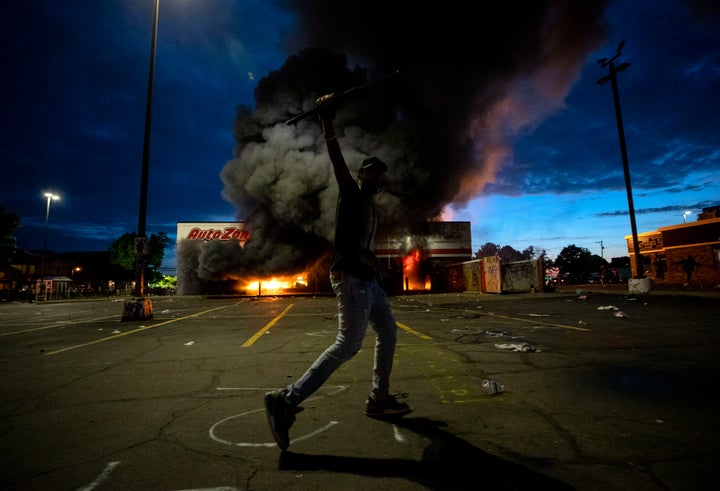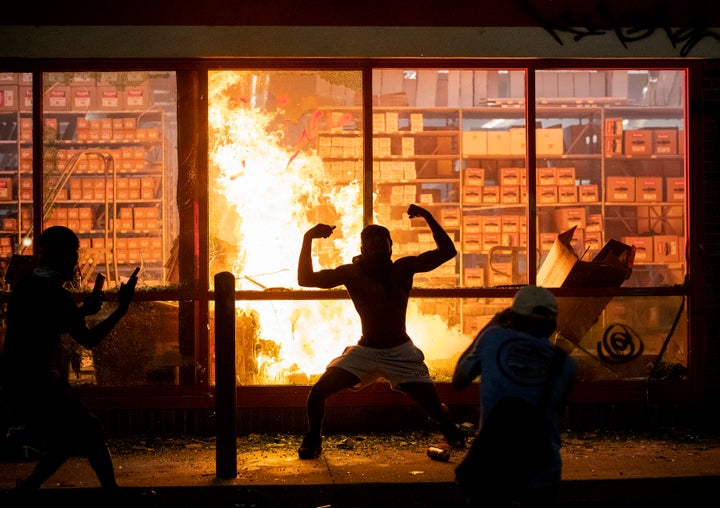Protests erupted in Minneapolis for the second day in a row on Wednesday over the death of George Floyd, a Black man who died after a white police officer knelt on his neck.
The demonstrations turned violent in some areas following a daylong protest outside a police station where officers used tear gas and rubber bullets to disperse attendees. Some people later began looting stores as night settled in, setting an AutoZone retail outlet on fire and carrying goods out of a vandalised Target. Police said early Thursday one person was shot and killed at a pawn shop by the store’s owner as officials urged residents to go home.
“Please, Minneapolis, we cannot let tragedy beget more tragedy,” the city’s mayor, Jacob Frey, said early Thursday morning per The Minneapolis Star-Tribune. He continued: “Yes, we’re reeling. We are reeling, and I understand the anger and pain, and we need the public’s help in keeping the peace tonight. We need that in order to get through this together.”
Frey had called for charges to be filed in Floyd’s death earlier in the day.

Minneapolis Police Chief Medaria Arradondo told Fox 9 News on Wednesday that a majority of the protesters had been peaceful, but said some had caused “significant property damage” and used Molotov cocktails.
As protests continued to rock Minneapolis on Wednesday, Jamar B Nelson, a veteran community activist, told The New York Times that the Black community long had a fraught relationship with police. “The truth is we do not have a good history,” Nelson said. “The biggest complaint is that the community feels the Police Department is racist, bigoted and uncaring about the Black community.”
Four Minneapolis Police Department officers were fired on Tuesday after a shocking video of Floyd’s arrest began to spread around the nation. In the clip, Floyd, who was detained on suspicion of using a counterfeit $20 bill, can be seen pinned to the street as an officer presses his knee into his neck, saying: “Please man, I can’t breathe. I cannot breathe. I cannot breathe.”
His eyes later close and he stops speaking as onlookers shout at the officers to help him. Police later called for an ambulance but Floyd died shortly after arriving at an area hospital.
The death sparked immediate comparisons to the shooting of Ahmaud Arbery, a Black man who was confronted and killed by two white men while jogging in Georgia earlier this year.
Protests over Floyd’s death also broke out in Los Angeles on Wednesday as demonstrators blocked traffic on a large freeway and clashed with police.

Minnesota Governor Tim Walz urged citizens to protest peacefully earlier Wednesday, saying residents’ feelings of “anger, anguish and disillusionment are justified.”
“If you plan to turn your pain into action by joining a public demonstration, please do so peacefully and safely to protect your own health and the health of the people around you,” Walz wrote on Twitter.
Later that night, however, the governor said the situation had evolved into an “extremely dangerous” confrontation and asked people to leave so paramedics could get to the scene.
Walz’s office told the Star-Tribune late Wednesday around 60 State Patrol troopers had been called in to help quell the demonstrations.

